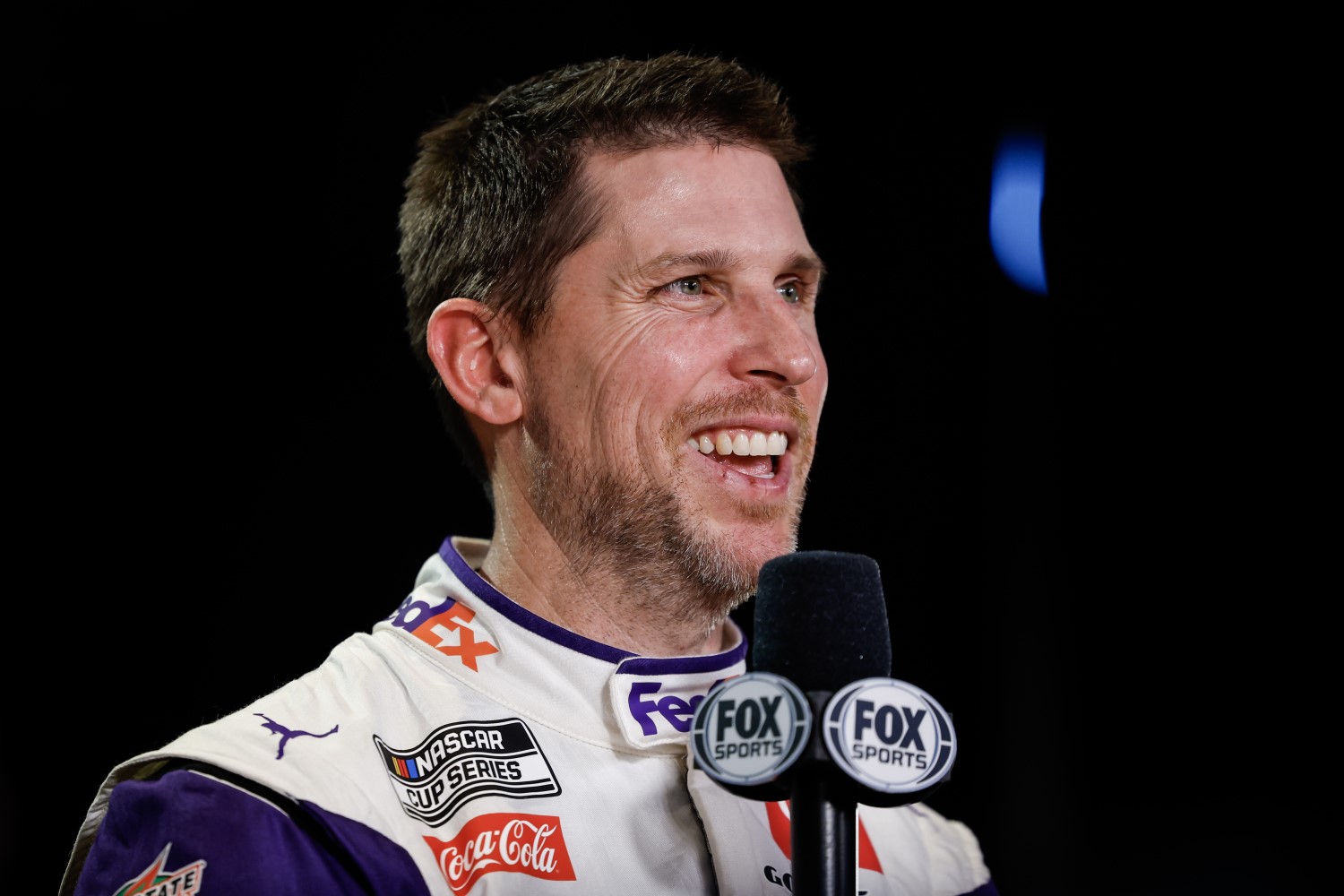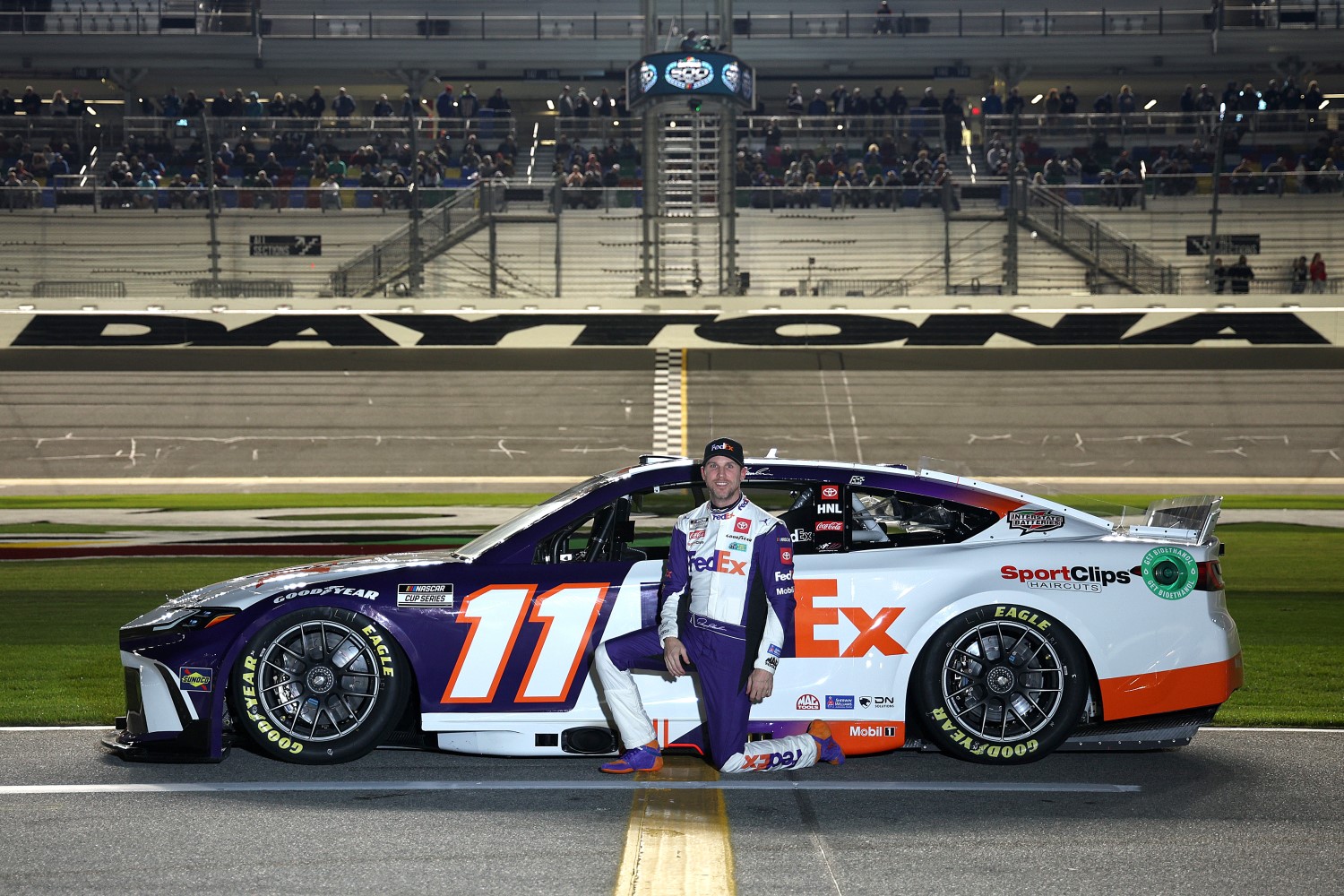NASCAR News: Hamlin pans the Next Gen car
Denny Hamlin topped the leaderboard in Friday evening’s NASCAR Cup Series Next-Gen practice session at Daytona International Speedway with a 197.477 mph lap in the No. 11 Joe Gibbs Racing Toyota.
Erik Jones’ No. 43 Legacy Motor Club Toyota was second fastest at 197.468 mph. Christopher Bell (197.429 mph), Ty Gibbs (197.394 mph) and John Hunter Nemechek (197.377 mph) rounded out the top five.
The rest of the top 10 included Tyler Reddick (197.364 mph), Jimmie Johnson (197.282 mph), Bubba Wallace (197.126 mph), Michael McDowell (194.569 mph) and Austin Cindric (194.523 mph).
Joe Gibbs Racing driver Denny Hamlin was made available to the media at the Daytona International Speedway, and he lit into the Next Gen car.
DENNY HAMLIN, No. 11 FedEx Toyota Camry XSE, Joe Gibbs Racing
Does Toyota have a big advantage this weekend?
“It’s more the way it worked out for sure. We had a big tow from another manufacturer pack of cars and that really plays a big factor into what kind of lap times you run and whatnot. When there weren’t as many cars out there, we ran about the same speeds as everyone else.”
Have you identified a favorite in this race?
“There are none in this race. There is no favorite in this race.”

Have you noticed any differences with the new Toyota Camry body in the draft?
“Yes and no. It’s very similar to what we had in the past. I think how you connect to cars and how long you can stay attached is really circumstantial to what kind of technique you use to get there and then do you have enough push to come from behind. Maybe I noticed that I can get pushed a little bit straighter than what it was in the past but it’s tough for me to say. It’s still not enough time and data points to really pinpoint what exactly is different.”
Was there ever any internal concern after qualifying results on Wednesday?
“Yeah, we kind of knew we were not going to be very good in the single car qualifying. I don’t think anyone thought it was going to be that bad for sure. But obviously it put our concerns to rest when it obviously raced well, right? I think there’s just a balance sometimes you have to strike there.”
What has changed from Gen 6 to the Next Gen car when it comes to drafting and do you feel like you have gained back what you lost, knowledge wise, with the Gen 6 car?
“Yeah, for sure. I think certainly it’s an evolution you’ve got to continue to change because the Next Gen cars do draft so much differently than what we saw for the Gen 6 cars. Obviously, you saw two-by-two racing. You’re going to see that for the bulk of Sunday as well. It’s just these Next Gen cars have a lot of drag in them which is why we qualify 20 miles an hour slower than we used to. So, with that, you’ve really got to stay in line for the bulk of the race. Once you establish whether you’re on the inside or the outside, there’s no real opportunities to make moves like you used to. So, you’ve got to just be patient and try to cycle up to the front through strategy or pick the right lane when a lane starts to bobble, right? It’s just different in that aspect, so it takes a little more patience for the Next Gen.”
Do you have a good sense of what you can and can’t do with this new body?
“I do. I feel like I started to continue pushing the limits of pushing throughout the on-track time. Certainly, yesterday I really didn’t really lock on to with anyone or push anyone for most of the race – there were a few instances. But then, now it’s Friday and getting closer to Sunday and I’m starting to push the limits of how far can I go, how hard can I push and how long can I push. I feel pretty good about my understanding of that now.”
How do you judge something that may work in the Duel versus what will work in the race like the block you had on Michael McDowell?
“Yeah, 100 percent. I think it’s a little different situation because I know (Michael) McDowell had to protect his car so you can kind of put those guys in a little different spot because they are in protection mode. But certainly, going back and watching it I didn’t realize the run was as big as it was and it was certainly a very, very late block from my end. You watch it, you learn, and you try to figure out how you can do it better.”
Is it frustrating that superspeedway racing has become so strategy focused?
“You have to embrace it for sure. I think that strategy has become such a big deal at superspeedways because we are running so much slower than we were before. Although the speeds may show fast today in practice, a lot of that is because how tight we are able to be with each other. If the cars had less drag, they would run faster by themselves, and arguably not run as fast in a pack. You do have to suck it up and embrace it that it’s more strategy racing and it is craft racing. Now its craft racing now towards the end. When the pack starts going crazy, and the air starts getting disturbed, you have to figure out the right lane to be in, but for 95 percent of the race – it is all strategy and people are trying to spend the least amount of time on pit road as they can, save fuel and not get out of line, because the determinate and the drag of the car will take you to last.”
What is the balance of saving fuel or being in the front in the mix of things, but burning more fuel?
“If you save fuel, you are not going to go backwards, because no one is able to pull out and pass. If you try to pull out and try to start a third line, it’s going to be really impossible. What it allows you to do, is just run 10th and just sit there and run half throttle and save fuel, because you have no ambitions of going forward because you are not going to go forward unless you are pushing your line to try to get your whole line free – which that doesn’t happen. It’s a yo-yo affect. You see it constantly – it’s the inside line, and then it’s the outside line – they just do that back and forth till someone pulls down or pulls up. You know you’re not going anywhere so you just slow down by running half throttle, where in the old car if you did that, whoever is behind you is just going to pull out, pass you, and get back in line because the cars had less drag. The whole new ballgame of fuel strategy, and all of that, that is a Next Gen thing. It is not the teams just getting smarter over time – we are racing what we’ve got.”
